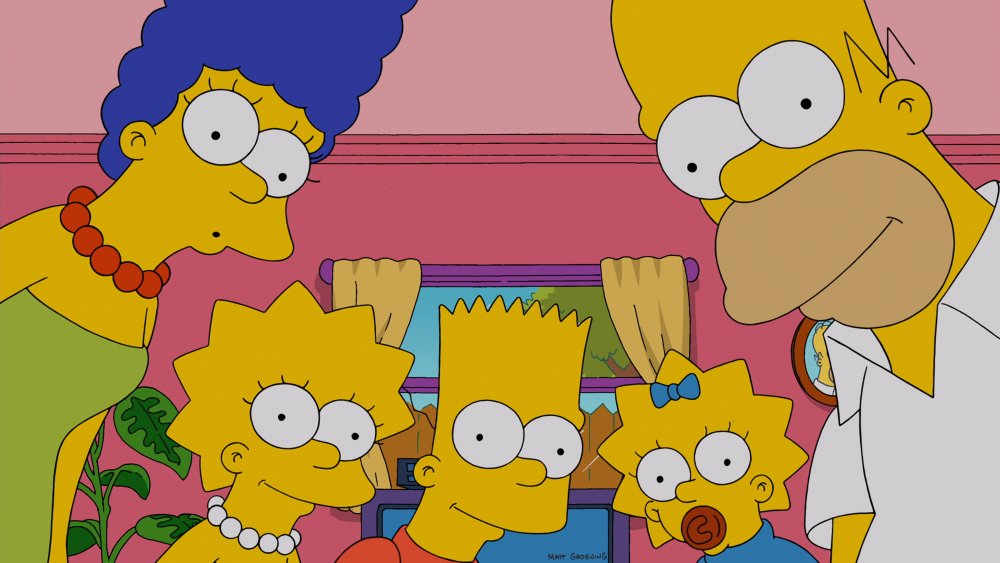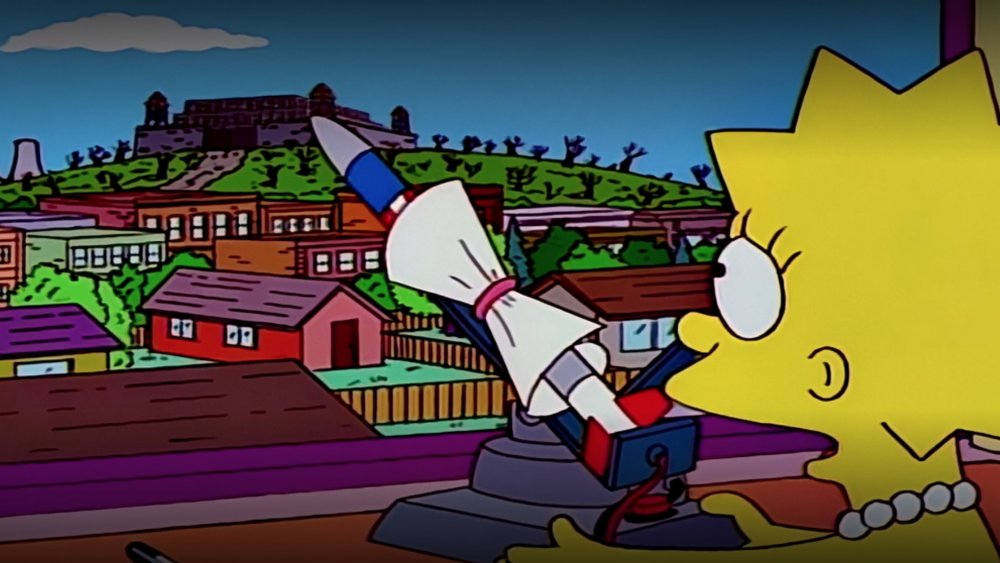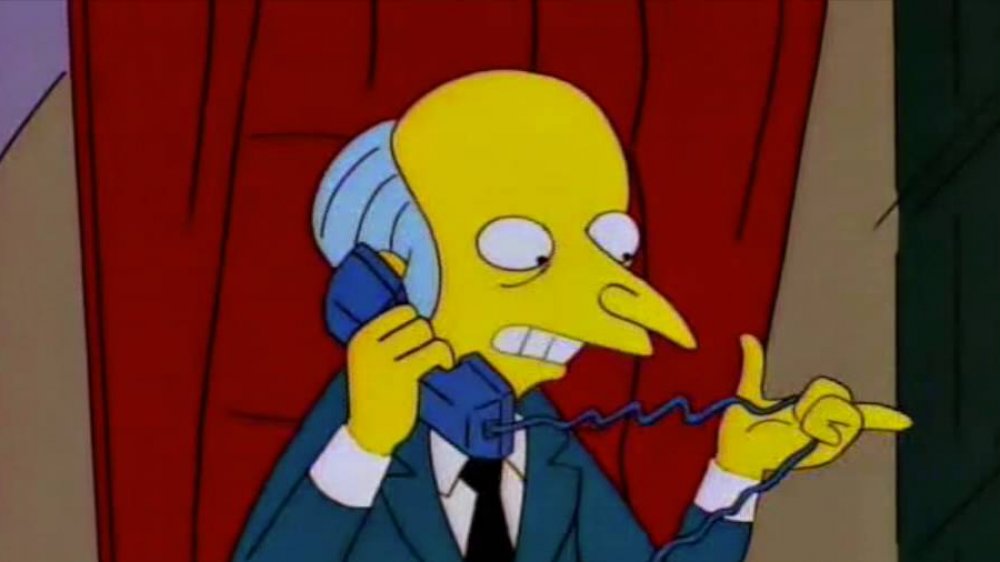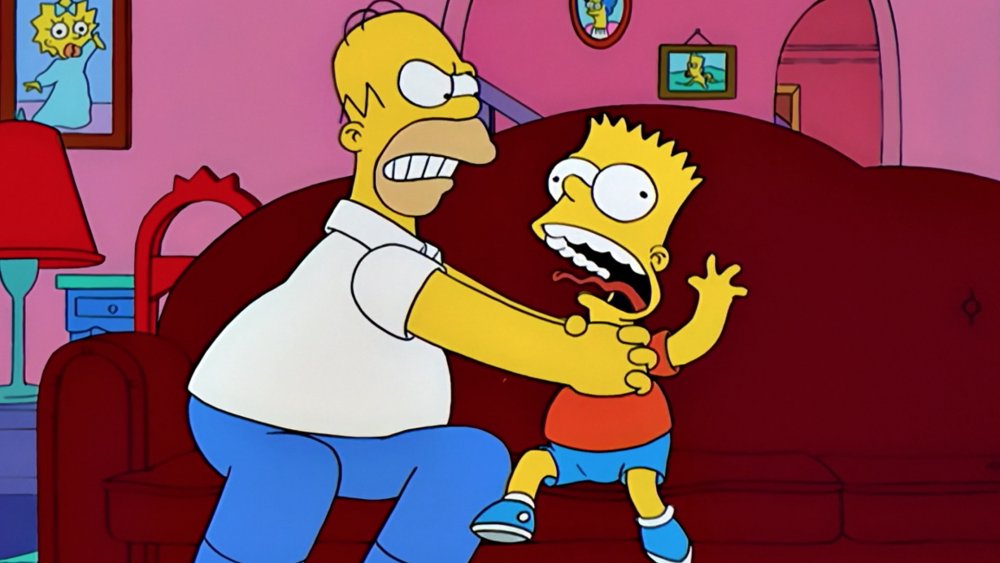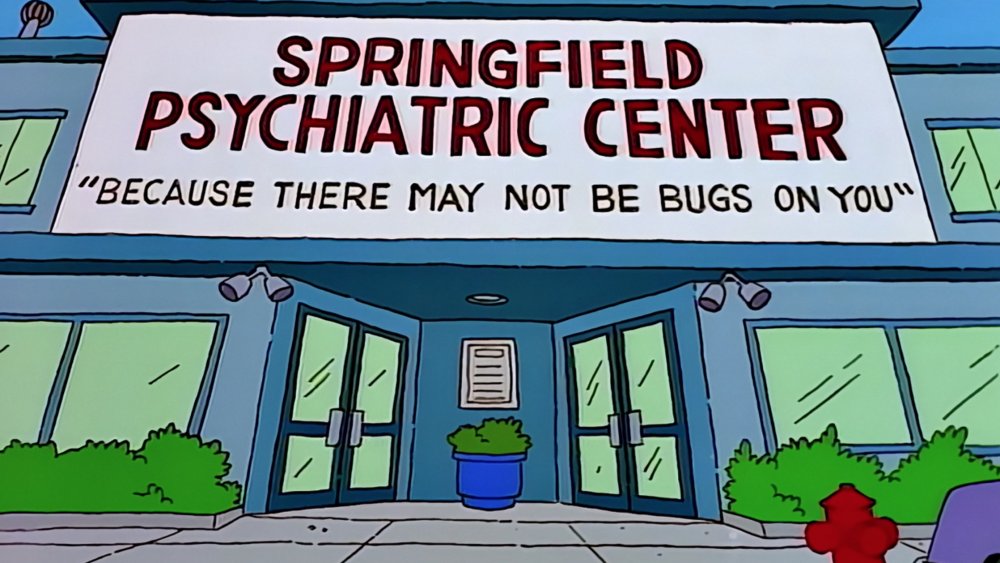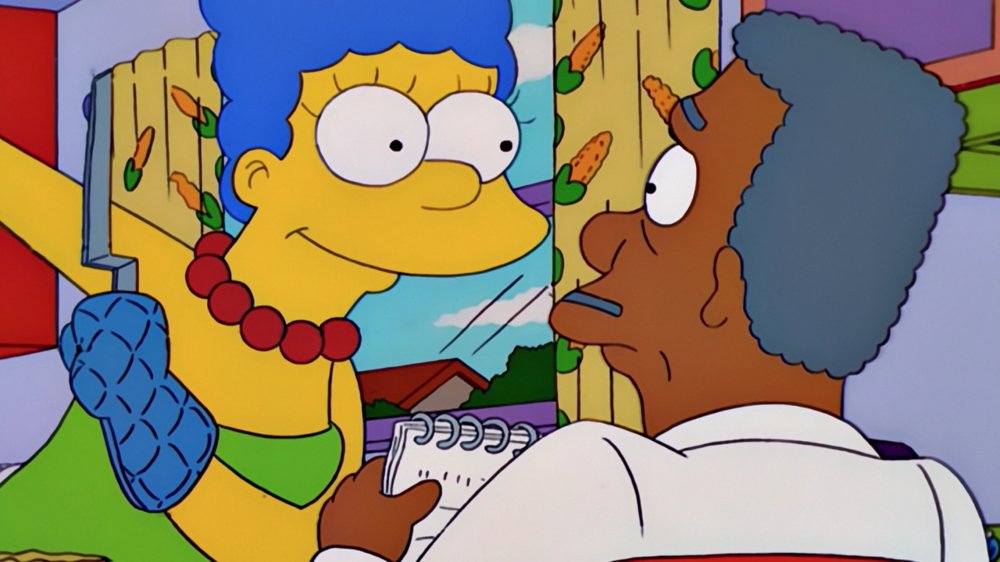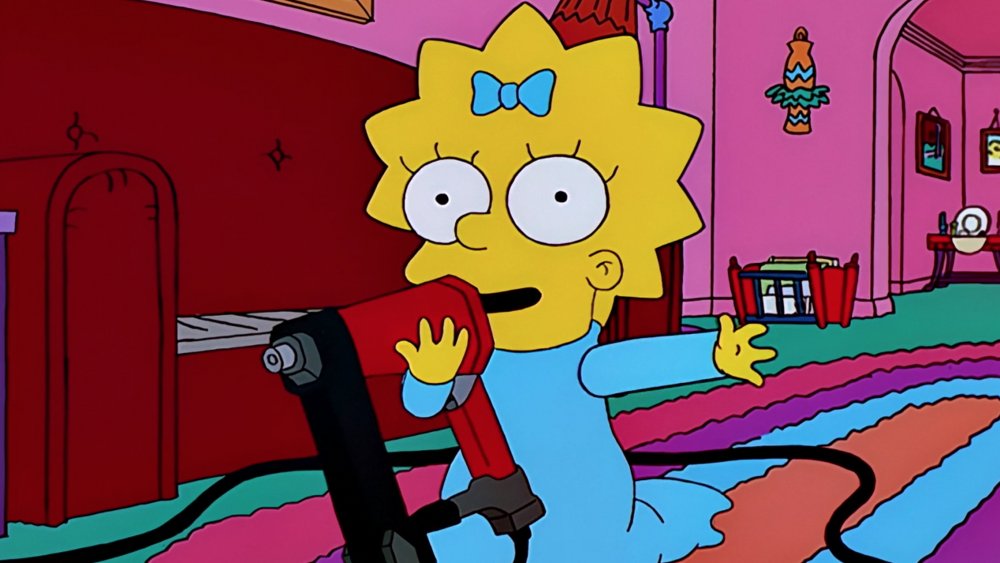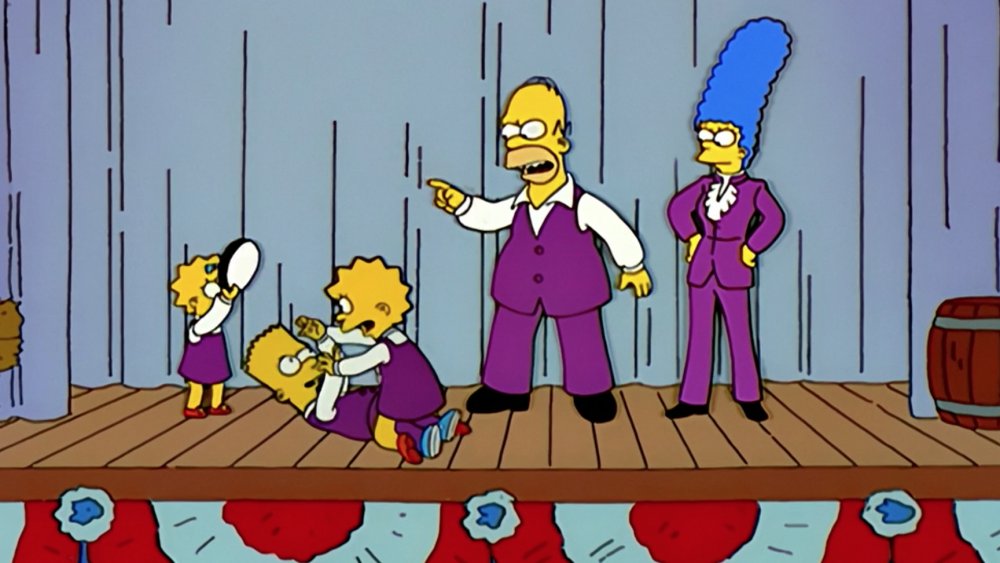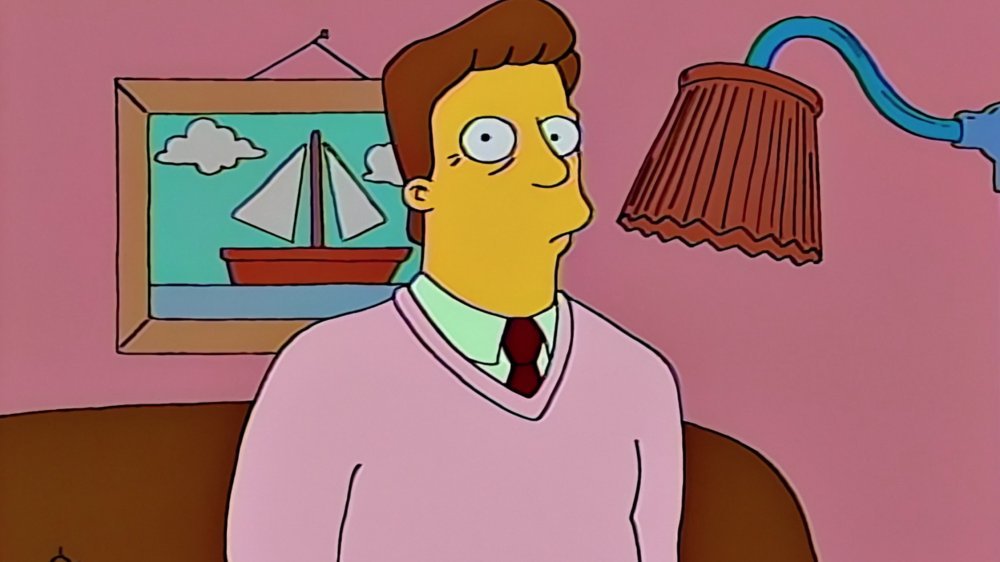Things Only Adults Notice In The Simpsons
The Simpsons, for all its wacky characters and gimmicks, adheres itself to a world of consequences and reality. Yes, Bart can be a perpetual fourth-grader, but he can't suddenly gain magical powers.
With the exception of the annual Treehouse of Horror series, in which all bets are off, the show has persisted for so many years because, at the end of the day, its characters rarely have to carry the events of the previous episode with them into the next. This allows the series to go as wild as it wants under the promise that nothing can't be undone by the end of a given episode. The minds behind the show colloquially refer to this concept as "flexible reality."
For many, The Simpsons is something they grew up with. An entire generation remembers laughing at Bart or Lisa until age made them suddenly relate more to Homer or Marge. However, with age also comes the benefit of hindsight. And thanks to the entire series being available to stream, that generation is binging The Simpsons as adults... and seeing those classic shenanigans through different eyes. Below are a few things that only adults notice when watching The Simpsons.
The geography of the house changes
The Simpsons have always lived at 742 Evergreen Terrace, right next to the Flanders family. Although the address itself is fixed, there have been several instances where the home's location within Springfield has changed wildly.
In season 6, episode 12, "Homer the Great," the viewer watches Homer suffer a long and uncomfortable commute. After he makes his way to his very meager and far away parking space, the camera pans out to reveal that his space is up against the fence connected to his back yard. In both season 9, episode 18 ("The Little Wiggy") and season 12, episode 10 ("Pokey Mom") a point is made about Springfield Prison being completely visible from the Simpsons' back yard as well.
Meanwhile, the mansion-like residence that former president George H.W. Bush moved into in season 7, episode 13 ("Two Bad Neighbors") is not usually visible in rare shots of the Simpson estate that show that side of the street.
Most animated shows don't bother themselves with the actual location of the character's house within the world. The Simpsons has more than earned the leeway to mess with the geography of 742 Evergreen Terrace. However, it's not until you binge the show as an adult that you would even think to look for things like that.
"Ahoy-hoy"
If you ask people today, they'll simply recognize "Ahoy-hoy" as the old-timey greeting that C. Montgomery Burns gives when answering a telephone. However, adults with an affinity for history may actually recognize it as a wink to one of history's more whimsical rivalries.
The joke here is that Mr. Burns is quite old. Old enough, in this instance, to remember what the inventor of the telephone believed the proper greeting should be when answering one. After inventing the thing that we all literally carry in our pocket today, Alexander Graham Bell insisted that the proper way to pick up the dial and speak was to shout: "Ahoy!"
According to NPR, it was a more commonly used expression at the time, even though it was derived from the Dutch word "hoi" and was mostly used in nautical contexts. Often people would repeat it, making "ahoy ahoy" somewhat common as well.
Inventing the telephone can get you far, but the New York Times reports that "ahoy" was given the boot by the public once Thomas Edison came in and perfected telephone technology. In many ways, Graham Bell could be grateful to Burns for keeping his preferred greeting in the lexicon to this day. Burns' go-to answer may not open many people's minds to the fun history story behind its rise and fall, but if you start using it on your phone, Simpsons fans will still get a kick out of it, and that's something.
Homer abuses Bart
If you say "Why you little...!" to a Simpsons fan, they know you're about to reach for their neck. That's because a long-running gag on the show involves Homer getting so fed up with his rule-breaking and mischievous son that he starts to straight up strangle the 10-year-old child.
A grown man viciously choking the life out of a fourth grader is obviously no laughing matter. However, The Simpsons has made it just that for years. Obviously cartoon violence gets a little more of a pass because it's easier to feel detached from it. Looney Tunes never actually made a bunny chew on a stick of dynamite or ran a coyote off a cliff, after all.
However, it's still jarring to see as its audience grows up and maybe has kids of their own. The show has even addressed Homer's child abuse a few times. For example, in the reality-flexing season 11, episode 22 ("Behind the Laughter"), it's hinted that Homer the actor choked Bart for real between takes, but since it got laughs, "that horrible act of child abuse became one of our most beloved running gags."
In season 22, episode 17 ("Love is a Many Strangled Thing"), Homer actually goes to therapy to confront his strangulation of Bart only for his therapist, voiced by Paul Rudd, to end up strangling the impossible child himself.
Sign gags for days
There was a time when the only way to watch The Simpsons was through TV syndication. That meant no rewinding, skipping commercial breaks and may God help you if you had to use the bathroom. As a result, it was easy to miss something like a sight gag if you looked away at the wrong time.
In another example of The Simpsons being ahead of its time, the show has very rarely missed an opportunity to make a run-of-the-mill sign into a hilarious joke of some sort, even if viewers couldn't pause to read it. Every opening credits even has a new joke on the chalkboard Bart is writing on. These were complicated jokes put into the show knowing full well that large swaths of the audience wouldn't even bother trying to read them.
However, those that did picked up on some of the show's very best bits. In fact, when Disney+ launched with the full archive of The Simpsons available for the first time someplace other than FXX, fans were outraged that some of the best sign gags were completely cut out of the show. Fortunately for purists, the backlash from fans was enough to force Disney to release a statement promising to broadcast the show in its original aspect ratio, setting the stage for a new generation to frantically pause every establishing shot in the show.
Smithers' sexuality
It may sound silly given how out and proud Smithers can be in modern episodes set in a post-LGBTQ-awareness society. However, when The Simpsons began in the early 1990s, Smithers was a very closeted gay man with a crush on his very, very old boss.
For those of us who grew up watching those early episodes, it might have been hard to suss out a reference about Smithers' sexuality as esoteric as a parody of A Streetcar Named Desire in which Burns is shouting "Smithers" like Brando shouted "Stella" or a computer boot-up sound byte in which a semi-nude Burns tells Smithers that he's good at "turning him on." Some jokes were as subtle as Smithers noting that a conservative mayor could conflict with his "chosen lifestyle" or taping over Burns' Ride of the Valkyries tape with Waterloo by Abba (a toe-tapper regardless of sexual orientation).
Alas, there was a time when there was comedy to be mined in the idea of a grown man hiding his sexual orientation from a town of his peers. Fortunately, by 2015 Smithers and the rest of Springfield were ready for an openly gay man. In the episode "The Burns Cage," Smithers finally comes out to Mr. Burns after years of unrequited love. However, in the early days of the show, especially if you were a youngster who didn't quite understand what sexual orientation even was just yet, it was easy to miss some of these razor-sharp hints.
Marge's life is kind of sad
Obviously, everyone on The Simpsons lives in a bit of an exaggerated reality. However, there have been several moments throughout the series in which Marge Simpson gives fans a peek behind her curtain to a very sad, and very boring life.
When the family visits New York City, Marge is awestruck by some glamorous heels in a shop window. However, she laments that she already owns a pair of shoes... One pair of shoes. While the show has proven time and again that the family's money is tight, the joke seems to be more that Marge can't fathom a world in which someone would own two pairs.
The evidence doesn't stop there. A few things that hint that Marge lives a needlessly sad and simple life include making homemade Pepsi for a dance, finding potatoes "neat" and, of course, this incredibly creepy line from the episode "Brawl in the Family": "Food keeps my family happy, so I make a few practice dinners before showtime, 'cause at 6 o'clock, we go live!"
Marge is the quintessential American mother. However, for all the moments that she's a loving and fierce matriarch of the Simpson family, there are very subtle hints that the life of an American housewife as people traditionally see the role can be quite... depressing for her. Fortunately, both the real-life moms and Marge find a way to keep things spicy such as joining the police force and starting a pretzel business.
Maggie Simpson is violent
After she famously shot Mr. Burns for trying to take her lollipop away, Maggie was thought to be just an innocent baby. However, there are several moments after that fateful day that prove the little youngster got a taste for blood.
In Season 12, Episode 16 ("Bye Bye Nerdie"), Maggie takes advantage of Homer's quest to baby-proof the house by grabbing his nail gun and basically lighting him up to the point that he needs Marge to take her out of the room in a rage. It is implied several times throughout subsequent seasons that the youngest Simpson child has a mortal rivalry with the unibrow baby that's often seen out and about in Springfield.
Let's also not forget the time that Maggie straight up sniped Mafia members on the family lawn. In season 13, episode 22 ("Poppa's Got a Brand New Badge"), Homer is confronted by Fat Tony and other mobsters at the house and Maggie, who has been hiding a rifle under her crib for some reason, fights them off without anyone realizing.
Whether it's being proficient with firearms or simply busting her bottle to make a glass shiv, Maggie Simpson definitely has a violent streak that's more worthy of attention than her unrelenting pacifier habit. However, it's hard to really notice unless you're binge-watching the show.
The Simpsons: Behind The Laughter breaks canon
Season 11, episode 22 ends on a high note for fans of the show with the Behind the Music parody Behind the Laughter. In it, the Simpson family is treated like real-life actors playing exaggerated versions of themselves on a TV show. It addresses some of the real-life creators of the show and showcases the family dealing with the fame of being associated with something as popular and successful as The Simpsons.
Although it's one of the writers' favorites and is acclaimed by fans, it's also one of the only times that the show breaks the fourth wall and portrays something that can't really be undone within the universe outside of a Treehouse of Horror installment. While a show as beloved as The Simpsons has to pay close attention to its own canon, Behind the Laughter seems to get a pass among fans and critics alike. In fact, showrunner Al Jean admitted in an interview with Entertainment Weekly that he envisioned the episode as a series finale to The Simpsons knowing full wall that (God willing) that day will never come. Still, these semantical gripes are something that only a seasoned, adult viewer would notice.
Homer can take an inhuman amount of punishment
Some of the best moments in The Simpsons come from Homer getting horribly maimed. Given that the show is a cartoon, it makes sense for there to be some brazen physical comedy and even slapstick violence. When operating under the flexible reality rule, it's OK for someone like Homer to go through the intense physical horrors that would cripple a live-action sitcom dad.
In the past, Homer has fallen down Springfield gorge (twice), crashed his car into a chestnut tree, been beamed in the head with a baseball, stood toe-to-toe with boxer Drederick Tatum, had his thumb cut off, got his hand stuck in a toaster (also twice), had a straw impale his eye, had a hammer impale his eye, had a car fall on him, had a chair broken over his body and been literally caught between a rock and a hard place.
Cartoon violence can be hilarious. However, only adults that have to worry about things like healthcare and permanent injury notice just how much punishment Homer Simpson is able to take throughout the course of the series and still come out smiling.
Local vs. Hollywood celebrities
Springfield has a handful of stars that call the sleepy little town their home. However, over the years characters like Krusty the Clown, Rainier Wolfcastle and Troy McClure (who you may remember from such films such as The Wackiest Covered Wagons in the West, Get Confident, Stupid and Dial M for Murderousness) have seemingly appeared as both hyper-local celebrities as well as major A-list Hollywood stars.
For example, in addition to Wolfcastle presenting at the Academy Awards, his other celebrity duties have included judging local radio station KBBL's "How Low Will You Go" contest along with Krusty and Madeleine Albright.
Meanwhile, Krusty's show definitely films in Springfield, but it's not very clear where exactly it airs. At times it seems like a local TV station variety show aimed at children, at other times it seems like it's in a ratings fight with other big network shows.
For all intents and purposes, Wolfcastle, McClure and Krusty's recognizability outside Springfield is almost never important to the plot of a given episode. However, when you start to grow up and realize that The Simpsons seems to operate in a world where the concept of celebrity fluctuates, it tends to become one of those logical sticking points that flexible reality is made of.
